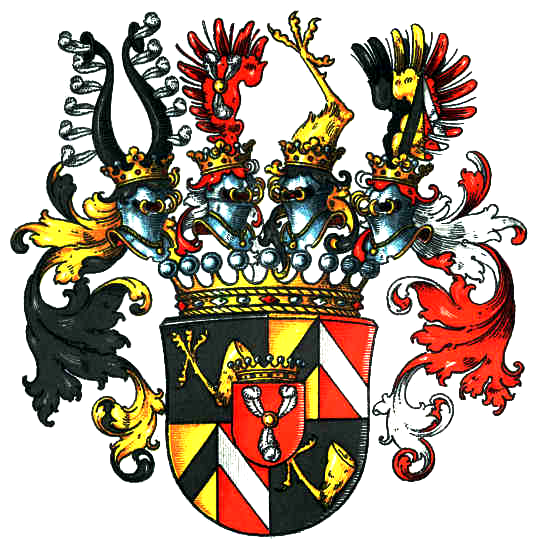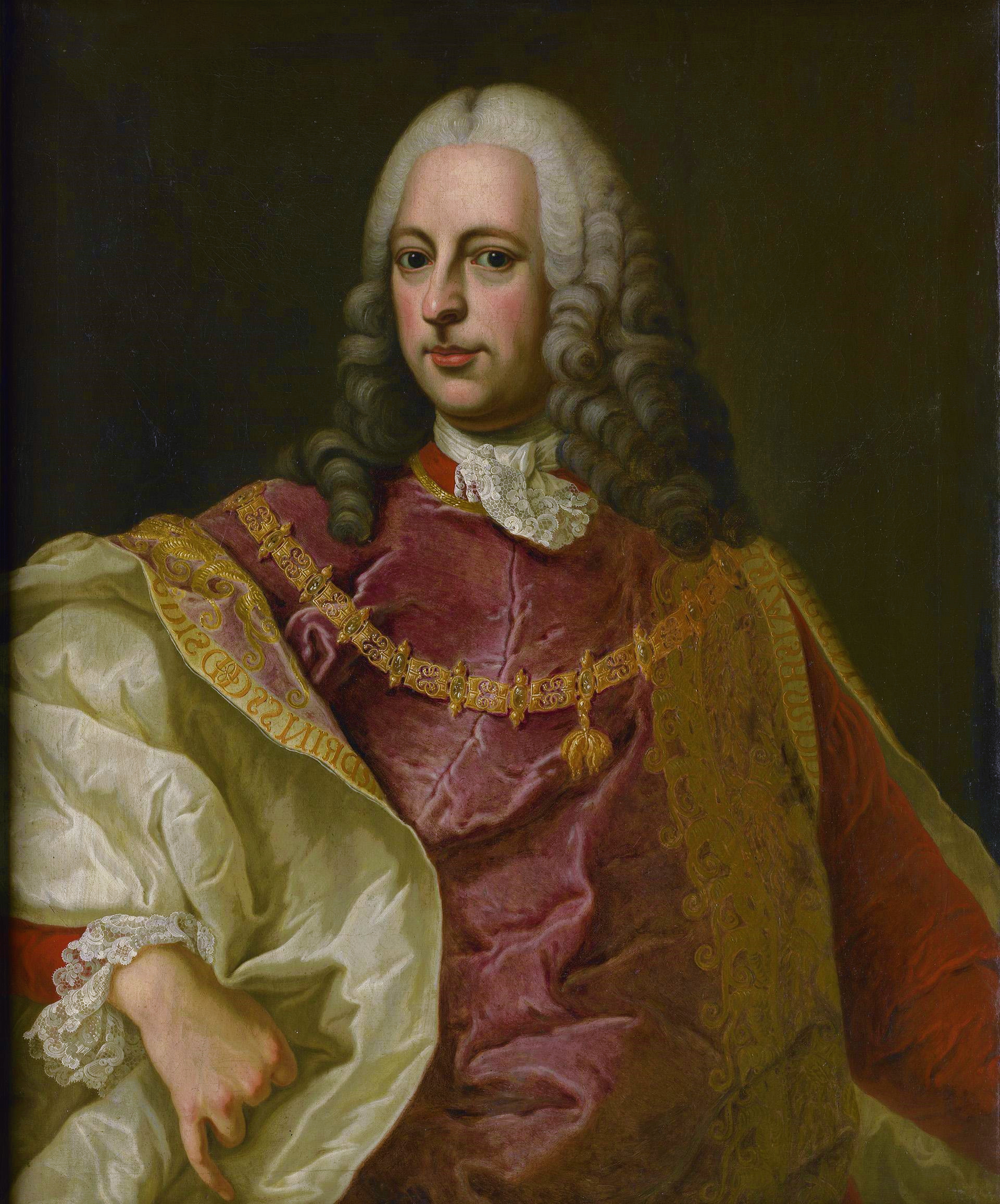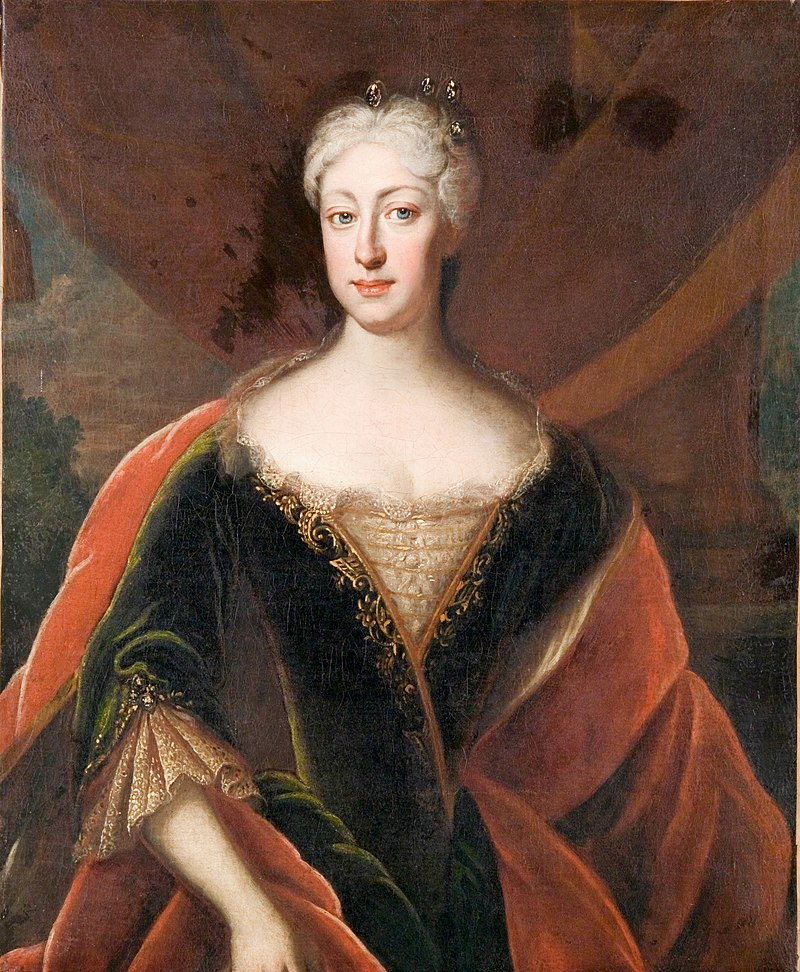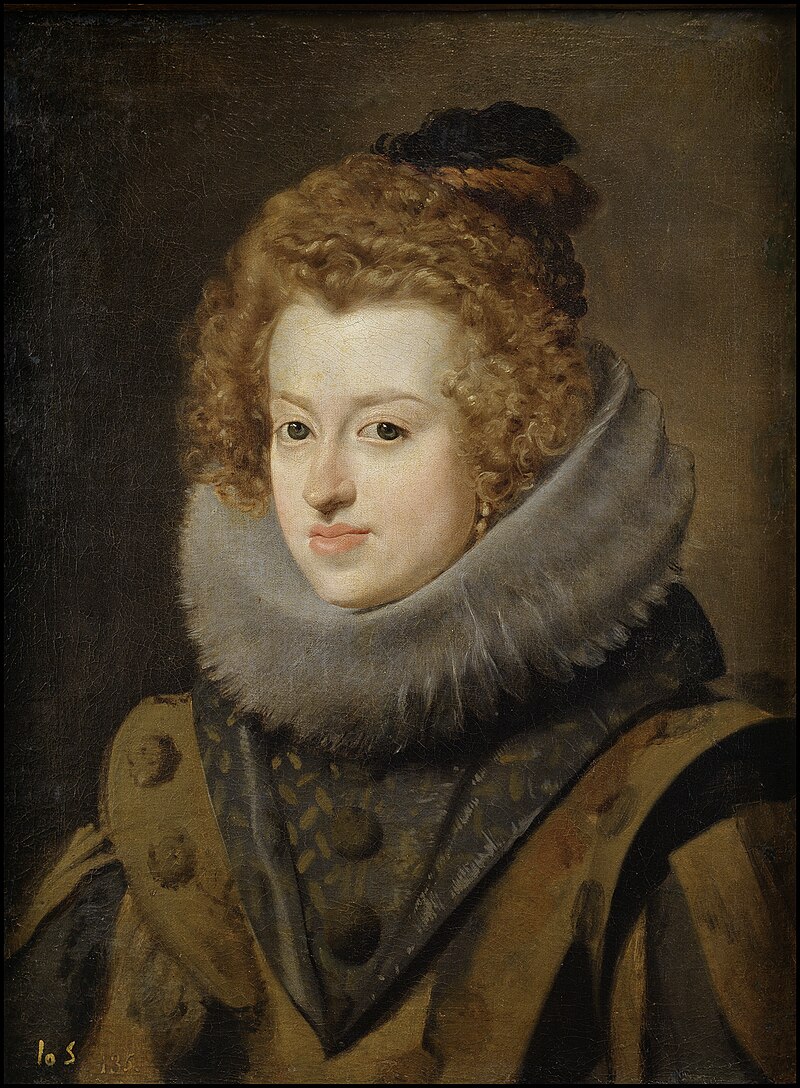by Susan Flantzer
© Unofficial Royalty 2023

Arms of the Counts of Harrach zu Rohrau und Thannhausen; Credit – Wikipedia
Countess Maria Josefa von Harrach-Rohrau was the wife of her first cousin Johann Nepomuk Karl, Prince of Liechtenstein. Born on November 20, 1727, in Vienna, then in the Archduchy of Austria, Maria Josefa was the seventh of the sixteen children and the fourth of six daughters of Count Friedrich August von Harrach zu Rohrau und Thannhausen and Maria Eleonore of Liechtenstein.

Maria Josefa’s father Count Friedrich August von Harrach zu Rohrau und Thannhausen; Credit – Wikipedia
The House of Harrach was an old and influential Austro-German noble family which was also part of Bohemian nobility. The Counts of Harrach (the German Graf/Gräfin = Count(ess) were among the most prominent families in the Holy Roman Empire. A confidant of Holy Roman Emperor Leopold I, Maria Josefa’s father served the House of Habsburg as Plenipotentiary Minister of the Habsburg Netherlands (1732 – 1741), Governor-General of the Habsburg Netherlands (1741 – 1744), and High Chancellor of Bohemia (1745 until he died in 1749). Maria Josefa’s paternal grandparents were Count Aloys von Harrach and his second wife Anna Cäcilia von Thannhausen. Her maternal grandparents were Anton Florian, Prince of Liechtenstein and Countess Eleonore Barbara von Thun-Hohenstein.
Maria Josefa had fifteen siblings:
- Franz Anton von Harrach-Rohrau (1720 – 1724), died in childhood
- Maria Rosa von Harrach-Rohrau (1721 – 1785), married her paternal uncle Ferdinand
- Bonaventura II, Count of Harrach, had one daughter
- Johann Josef von Harrach-Rohrau (1722 – 1746), unmarried
- Ernst Guido, Count von Harrach, zu Rohrau and Thannhausen (link in German) (1723 – 1783), married Maria Josefa von Dietrichstein-Proskau, had four children
- Maria Anna von Harrach-Rohrau (1725 – 1780), married Nikolaus Sebastian Graf von Lodron-Laterano und Castelromano, had ten children
- Anna Viktoria von Harrach-Rohrau (1726 – 1746), died unmarried at age 19
- Maximilian Josef von Harrach-Rohrau (1729 – 1730), died in infancy
- Bonaventura Maria von Harrach-Rohrau (1731 – 1794), unmarried
- Ignaz Ludwig von Harrach-Rohrau (1732 – 1753), died unmarried at age 20
- Franz Xaver von Harrach-Rohrau (1732 – 1781), married Maria Rebecca von Hohenems, had one daughter
- Johann Leopold von Harrach-Rohrau (1733 – 1734), died in infancy
- Maria Elisabeth von Harrach-Rohrau (born and died 1735)
- Ferdinand von Harrach-Rohrau (1737 – 1748), died in childhood
- Johann Nepomuk Ernst von Harrach-Rohrau (1738 – 1739), died in infancy
- Maria Christina von Harrach-Rohrau (1740 – 1791), unmarried

Johann Nepomuk Karl, Prince of Liechtenstein; Credit – https://fuerstenhaus.li/en/die-biographien-aller-fuersten/18-century/
On March 19, 1744, in Vienna, Austria, seventeen-year-old Maria Josefa married her first cousin, twenty-year-old Johann Nepomuk Karl, Prince of Liechtenstein, the son of her maternal uncle Josef Johann Adam, Prince of Liechtenstein and his third wife Maria Anna Katharina of Oettingen-Spielberg.
Maria Josefa and Johann Nepomuk Karl had three children:
- Princess Maria Anna of Liechtenstein (1745 – 1752), died in childhood
- Prince Joseph Johannes Nepomuk of Liechtenstein (born and died 1747), died in infancy
- Princess Maria Antonia of Liechtenstein (1749 – 1813), born after her father’s death, married Prince Wenzel Chrisostumus von Paar, had ten children
Four years after his marriage to Maria Josefa, Johann Nepomuk Karl, Prince of Liechtenstein died at the age of 24, on December 22, 1748, in Wischau, Kingdom of Bohemia, now in the Czech Republic. He was buried in the Old Crypt at Chuch of the Nativity of the Virgin Mary in Vranov, Moravia, now in the Czech Republic.
On November 28, 1752, Maria Josefa made a second marriage to Prince Joseph Maria von Lobkowicz (1724 – 1802), a Field Marshal in the Imperial Austrian Army. The von Lobkowicz family is one of the oldest Bohemian noble families and dates back to the 14th century.
Maria Josefa and her second husband had four children:
- Joseph Bernard von Lobkowicz (1754 – 1768), died in his early teens
- Marie Eleonore von Lobkowicz (1753 – 1802), unmarried, a nun in Vienna
- Maria Josepha von Lobkowicz (1756 – 1823)
- Ferdinand von Lobkowicz (1759 – 1761), died in early childhood

The Capuchin Church of St. Wenceslas in Roudnice nad Laberm where Maria Josefa was buried; Credit – Wikipedia
Maria Josefa predeceased her second husband and survived her first husband by forty years, dying at the age of 61 on February 15, 1788, in Roudnice nad Laberm, then in the Kingdom of Bohemia, now in the Czech Republic, which was owned by the Lobkowicz family and remained under their control until 1945. She was buried in the Lobkowicz family crypt (link in Czech) at the Capuchin Church of St. Wenceslas (link in Czech) in Roudnice nad Laberm, but her tomb has not survived.
This article is the intellectual property of Unofficial Royalty and is NOT TO BE COPIED, EDITED, OR POSTED IN ANY FORM ON ANOTHER WEBSITE under any circumstances. It is permissible to use a link that directs to Unofficial Royalty.
Works Cited
- Flantzer, Susan. (2021) Johann Nepomuk Karl, Prince of Liechtenstein, Unofficial Royalty. Available at: https://www.unofficialroyalty.com/johann-nepomuk-karl-prince-of-liechtenstein/ (Accessed: 05 July 2023).
- Friedrich August, Graf von Harrach zu Rohrau (2023) geni_family_tree. Available at: https://www.geni.com/people/Friedrich-August-Graf-von-Harrach-zu-Rohrau/6000000015491455371 (Accessed: 05 July 2023).
- Friedrich August von Harrach-Rohrau (2023) Wikipedia (German). Available at: https://de.wikipedia.org/wiki/Friedrich_August_von_Harrach-Rohrau (Accessed: 05 July 2023).
- Harrach (2023) Wikipedia. Available at: https://en.wikipedia.org/wiki/Harrach (Accessed: 05 July 2023).
- Kostel Svatého Václava (Roudnice nad Labem) (2023) Wikipedia (Czech). Available at: https://cs.wikipedia.org/wiki/Kostel_svat%C3%A9ho_V%C3%A1clava_(Roudnice_nad_Labem) (Accessed: 05 July 2023).
- Lobkovická hrobka (Roudnice nad Labem) (2023) Wikipedia (Czech). Available at: https://cs.wikipedia.org/wiki/Lobkovick%C3%A1_hrobka_(Roudnice_nad_Labem) (Accessed: 05 July 2023).
- Lobkowicz Family (2023) Wikipedia. Available at: https://en.wikipedia.org/wiki/Lobkowicz_family (Accessed: 05 July 2023).
- Maria Josefa von Harrach (2023) Wikipedia (German). Available at: https://de.wikipedia.org/wiki/Maria_Josefa_von_Harrach (Accessed: 05 July 2023).




















